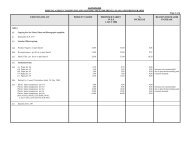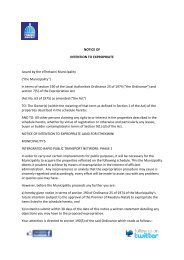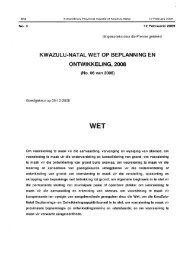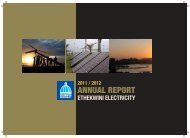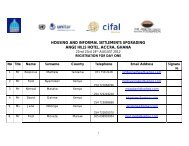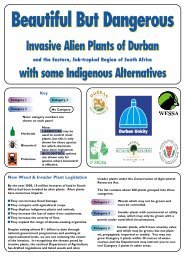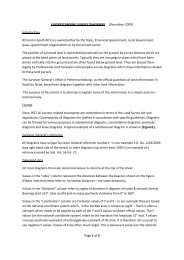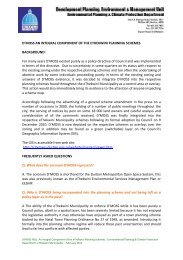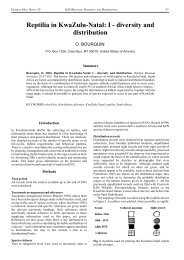Mullin, S. K., Taylor, P. J. & Pillay, N. 2004. Skull size and ... - Durban
Mullin, S. K., Taylor, P. J. & Pillay, N. 2004. Skull size and ... - Durban
Mullin, S. K., Taylor, P. J. & Pillay, N. 2004. Skull size and ... - Durban
You also want an ePaper? Increase the reach of your titles
YUMPU automatically turns print PDFs into web optimized ePapers that Google loves.
MULLIN_08 13/08/04 12:45 Page 22<br />
<strong>Mullin</strong> S. K. et al.<br />
the largest <strong>size</strong> of all of the Dasymys specimens<br />
examined here. Another distinguishing character<br />
of D. nudipes is that its tail length is longer on<br />
average than its body length, a unique trait that<br />
makes D. nudipes distinguishable from all other<br />
species (Table 3). Dasymys nudipes occurs in an<br />
Angolan escarpment zone that is associated with<br />
several other endemic rodent species (Hall 1960;<br />
Crawford-Cabral 1983; <strong>Taylor</strong> & Kumirai 2001).<br />
The biological importance of this area is thought to<br />
be due to palaeoclimatic changes, mainly the expansion<br />
of the Kalahari Desert into northern Angola<br />
<strong>and</strong> Congo disrupting what was considered to be<br />
a continuous forest from Angola to Cameroon.<br />
Several workers have suggested that Okavango<br />
Delta specimens might represent a subspecies of<br />
D. nudipes due to its large <strong>size</strong> (Shortridge 1934;<br />
Roberts 1951; Crawford-Cabral & Pacheco<br />
1989; Musser & Carleton 1993). Although the<br />
ventral skull shape is similar to D. nudipes, the<br />
traditional measurements, dorsal shape of the<br />
skull as well as the ANOVA results suggest that<br />
this material may delineate a good morphological<br />
species that is distinct from D. incomtus (both<br />
from South Africa <strong>and</strong> Angola) <strong>and</strong> D. nudipes.<br />
Only one of the Botswana OTUs (Moremi) is<br />
part of the Okavango Delta group. Individuals<br />
from the second Botswana OTU (Kasane) consistently<br />
grouped away from the other Okavango<br />
Delta material <strong>and</strong> instead had a similar skull<br />
shape <strong>and</strong> <strong>size</strong> to South African D. incomtus senso<br />
lato <strong>and</strong> should be included within an incomtus<br />
P R O O F<br />
group. We suggest that Okavango Delta Dasymys<br />
be named D. shortridgei, after G.C. Shortridge<br />
who provided the majority of the collection from<br />
this region, pending genetic confirmation of species<br />
status (see Appendix 1).<br />
Dasymys rufulus is distinct from South African<br />
D. incomtus as well as from D. i. griseifrons <strong>and</strong><br />
D. nudipes, but does not appear to be restricted to<br />
west Africa as suggested by Carleton & Martinez<br />
(1991), who previously hypothesised that the<br />
range of D. rufulus at least extended into<br />
Cameroon. Specimens from north Africa (Sudan<br />
<strong>and</strong> Chad), central Africa (Cameroon, Congo,<br />
western DRC <strong>and</strong> northern Angola), <strong>and</strong> central<br />
east Africa (Zambia, Tanzania, Malawi <strong>and</strong><br />
22<br />
Mozambique) are all currently recognised as<br />
D. incomtus (Musser & Carleton 1993) yet<br />
appear to have similar skull <strong>size</strong>s <strong>and</strong> shapes to<br />
D. rufulus based primarily on traditional measurements<br />
<strong>and</strong> dorsal skull shape data. The apparent<br />
large range of D. rufulus, spanning from Senegal<br />
to Tanzania (excluding East Africa) is in part<br />
confirmed by Ducroz et al. (2001) who found a<br />
low percentage of genetic divergence (7.2%)<br />
between D. rufulus from Lake Retba, Senegal <strong>and</strong><br />
D. incomtus from Berega, Tanzania using<br />
cytochrome b data.<br />
Ventral skull data showed possible boundaries<br />
between (a) west African <strong>and</strong> Zambian <strong>and</strong> (b)<br />
central African <strong>and</strong> Zambian material, which led<br />
us to hypothesise that central African <strong>and</strong><br />
Zambian material may represent distinct groups<br />
(either species or subspecies) within a rufulus<br />
species complex. Known historical faunal links<br />
between Nigeria, Gabon, Cameroon, the DRC<br />
<strong>and</strong> Angola support such a large area for a species<br />
complex (Hall 1960; Swanepoel & Schlitter 1978;<br />
Van der Straeten & Verheyen 1982; Robbins &<br />
Van der Straeten 1989; Louette 1990; Dieterlen<br />
& Van der Straeten 1992; Happold 1996). Also,<br />
the three regions that the rufulus complex covers<br />
(west, central <strong>and</strong> central east Africa) have been<br />
associated with other species complexes, variable<br />
karyotypes, newly identified species <strong>and</strong> a high<br />
occurrence of endemics in rodents (Hamilton<br />
1982; Van der Straeten & Dudu 1990; Hutterer<br />
et al. 1992; Van der Straeten & Dieterlen 1992;<br />
Stuart et al. 1993; Verheyen et al. 1996; Burgess<br />
et al. 1998; Grubb 1999; Grubb et al. 1999;<br />
Schlitter et al. 1999; Dobigny & Volobouev 2000;<br />
Barome et al. 2001; Burda 2001; Kawalika et al.<br />
2001; Lecompte et al. 2001; <strong>Taylor</strong> & Kumirai<br />
2001). Fauna from the Guineo-Congolian forest<br />
block has also been linked to eastern Tanzania<br />
(Poynton 1990; Kingdon & Howell 1993; Howell<br />
1993) in addition to material from west Africa.<br />
Musser & Carleton (1993) indicated that D. rufulus<br />
needed to be compared to material from central<br />
Africa <strong>and</strong> in particular to individuals representing<br />
D. i. bentleyae (occurring in southwestern DRC<br />
<strong>and</strong> northern Angola). In our study, material from<br />
the DRC was split into two morphologically<br />
MAMMALIA • 2004 • 68 (2)


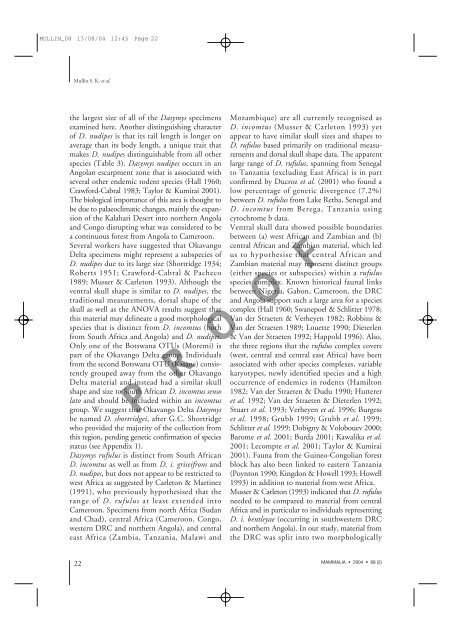
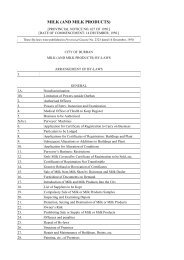
![INK Environmental Sustainability Booklet [19 MB] - Durban](https://img.yumpu.com/22025104/1/190x136/ink-environmental-sustainability-booklet-19-mb-durban.jpg?quality=85)

